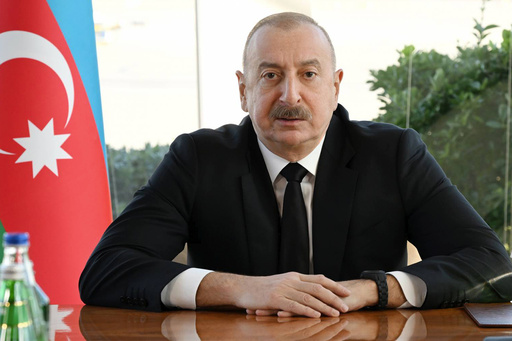Aviation experts stated on Thursday that the crash of an Azerbaijani plane that resulted in 38 fatalities the previous day may have been due to Russian air defense fire. The Embraer 190, operated by Azerbaijan Airlines, was traveling from Baku, the capital of Azerbaijan, to Grozny, a city in Russia’s North Caucasus, when it diverted for reasons that remain unclear and subsequently crashed while attempting to land in Aktau, Kazakhstan, after crossing the Caspian Sea.
The aircraft went down approximately 3 kilometers (about 2 miles) from Aktau with footage that circulated online showing it in a steep descent prior to impact, leading to a massive explosion upon hitting the ground. Additional videos depicted part of the fuselage separated from the wings, with the remainder of the plane overturned in a grassy area.
In a somber display of mourning, Azerbaijan lowered their national flags to half-mast and observed a nationwide moment of silence on Thursday, during which traffic halted at noon and sirens from ships and trains echoed in remembrance of the crash victims. President Ilham Aliyev addressed a news conference on Wednesday, reluctant to speculate about the cause but noting that adverse weather conditions had compelled the plane to alter its planned route.
Aliyev reported, “Information I have is that the plane changed its course between Baku and Grozny due to deteriorating weather and headed toward Aktau airport, where it ultimately crashed.” Preliminary reports from Russia’s civil aviation authority, Rosaviatsia, suggest that a bird strike forced the pilots to divert to Aktau in an emergency situation.
While officials from Azerbaijan, Kazakhstan, and Russia have not disclosed specific findings regarding the crash’s cause, an Azerbaijani lawmaker has pointed fingers at Moscow. Rasim Musabekov addressed the Azerbaijani news agency Turan, stating that the aircraft was likely targeted by fire while flying over Grozny and urged Russia to issue an official apology. He implored, “Those responsible must face criminal charges,” expressing concerns that failure to provide compensations for victims could strain relations.
As investigations commence, some experts have observed damage in the plane’s tail section which may indicate that it was struck by Russian air defense systems attempting to repel a Ukrainian drone assault. Drones have previously targeted Grozny and other locations in Russia’s North Caucasus. An official from Chechnya confirmed that an additional drone threat was thwarted on Wednesday, although this was not corroborated by federal authorities.
Expert Mark Zee from OPSGroup has analyzed images of the crashed aircraft and indicated a high likelihood—between 90-99%—that the plane was hit by a surface-to-air missile (SAM). Osprey Flight Solutions, a UK-based aviation security firm, informed clients that the incident likely involved a Russian military air-defense system. Their CEO, Andrew Nicholson, expressed sorrow at the loss of life that could have been prevented, in light of over 200 prior alerts about such threats in the region.
Additionally, independent military analyst Yan Matveyev pointed out that the damage depicted in the plane’s tail aligns with impact from shrapnel from smaller surface-to-air missiles, possibly from systems like the Pantsyr-S1. He raised questions about why pilots chose to venture further into the Caspian Sea rather than attempting to land at a nearer Russian airport after the aircraft was hit.
Caliber, a news site with reliable government sources in Azerbaijan, echoed claims that Russian air defense systems targeted the aircraft as it approached Grozny, criticizing Russian authorities for not closing the airport amid the apparent drone activity. Chechnya’s Security Council head, Khamzat Kadyrov, stated that their air defenses successfully intercepted drones in the area that same day. Caliber further queried why Russian officials did not permit the plane to make an emergency landing nearby after it sustained damage.
In response to these accusations, Kremlin spokesman Dmitry Peskov advised against forming conclusions until an official investigation concludes. Kazakhstan’s parliamentary speaker, Maulen Ashimbayev, also cautioned against hastily accepting the unverified claims regarding air defense fire, labeling them as unfounded.
Officials revealed that passengers aboard the ill-fated flight included a mix of 42 Azerbaijani citizens, 16 Russians, six Kazakhs, and three Kyrgyz nationals. In response to the tragedy, Russia’s Emergencies Ministry flew nine survivors to Moscow for medical care.



